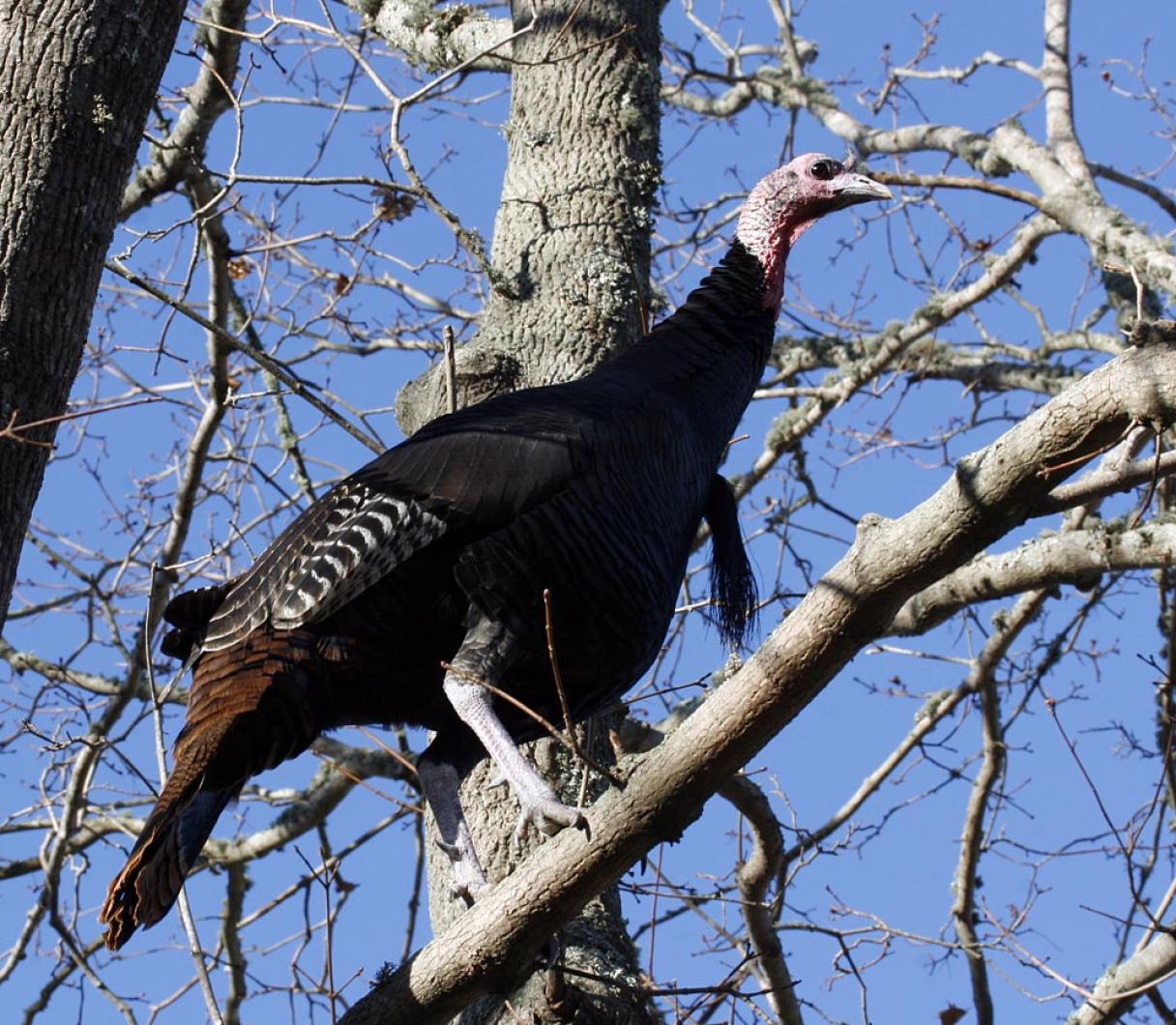Turkeys were in the news quite a bit this summer, and they have been in many stomachs recently. Flocks of live turkeys wander around in Tisbury, West Tisbury, Chilmark and to a lesser degree in Aquinnah, Edgartown and Oak Bluffs. Are these Island flocks wild turkeys? I would like to quote Vineyard Birds 2 which Barbara Pesch and I recently published. “The wild turkeys introduced by Gus Ben David from Arkansas in the 1970’s were extirpated in the ‘90’s. There are feral turkeys here. The down-Island population comes from domestic turkeys from Elisha Smith’s farm and the up-Island population comes from Craig Kingsbury’s farm. No doubt they have interbred and are a hodgepodge.” Feral turkeys are just another name for domestic turkeys that have gone “wild.”
It is not clear whether wild turkeys were part of the prehistoric avifauna of the Vineyard. The transplanted wild turkeys didn’t survive on the Island so maybe wild turkeys never made it to the Island in the distant past. So what do we have? The Vineyard boasts flocks of domestic turkeys which have gone feral. The birds that are seen on the Island are quite different from those that we eat. Turkeys that have been bred for the table weigh about twice as much as wild turkeys. As a result, domestic turkeys reared for our special occasions (Thanksgiving and Christmas meals) are usually so heavy they are unable to fly. Our feral turkeys are a slimmed-down version as they are not pen fed, are lighter in weight; therefore they able to fly.
I never understood why the turkey was called a turkey. Wasn’t turkey the name of a country before the bird was named? My research came up with the following. It seems that when the Spaniards came to the Americas and spotted the wild turkey in Latin America they captured one and took it back to Europe. That occurred back in the 1500’s. The British had a bird that was originally from Africa which they called a turkey-cock (because it came by way of Turkey) which resembled the bird that had been brought from the Americas. The bird the British called the turkey was actually a type of guinea fowl and I see some resemblance, but not much. The British domesticated the turkey that the Spaniards brought from the New World, and when the Englishmen started to cross the Atlantic and colonize New England, they brought these domestic turkeys with them.
Real wild turkeys are wary and if you spot one in the woods or along a roadside, they bolt instantly. The male, or tom, puts on quite a show to attract a mate. He starts by gobbling which attracts the female. Then, when he has the hen’s attention, he continues his routine by fanning his tail, lowers his wings so some of the primary feathers are dragging on the ground and raises the feathers on his back. These moves accomplished, the tom then throws his head back and his bill forward and moves around the female making either humming noises or gobbles. If the female likes what she sees, mating occurs.
The hen makes a shallow scrape in the soil and lays as many as 26 eggs. About 25 days later, the first poult (young turkey) hatches. The female feeds the poults for a few days. The tom has nothing to do with his offspring. The poults learn to feed themselves soon, but stay around their mother until the next breeding season. Frequently, several hens join together with their broods and in some areas winter groups of hens and their offspring can exceed 200 birds.
So I hope you had a good Thanksgiving and understand that the Vineyard turkeys are not real wild turkeys.
Bird Sightings
Lanny McDowell spotted a late tree swallow while trying to find a cave swallow on Nov. 18. Cave swallows have been reported from Cape Cod so Lanny was hoping one would cross the Sound. On Nov. 24 Lanny had a yellow-bellied sapsucker at his West Tisbury home and at Squibnocket he spotted a lone green-winged teal offshore in with a flock of common eiders. He also spotted two small groups of purple sandpipers. Amongst the rocks off the beach Lanny spotted a single longtailed duck with a pair of harlequin ducks.
Rob Bierregaard’s Web site showing the movements of the ospreys that have been tagged both on and off Island is fascinating. Homer, the youngster that was tagged on the Vineyard in 2005, has unfortunately not been heard from since early October. He spent the winters of 2005, 2006 and also 2007 in Venezuela. He was back on the Vineyard in May of 2008 and then headed south to be lost in October. We hope it is a bad transmitter and not death that keeps us from knowing anything more about Homer.
Penelope, who was tagged on the Island this summer, went south, had a sojourn in the Brazilian Amazon and has settled in French Guyana for the winter. Como, another Vineyard osprey, is spending his winter in Cuba. Meadow did some crazy moves including time in Canada, Maine and Ohio before his most recent move to North Carolina. Seems he doesn’t feel the cold as badly as the others.







Comments
Comment policy »